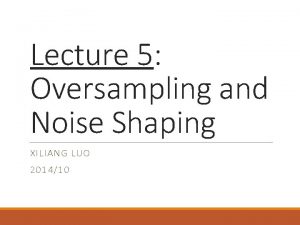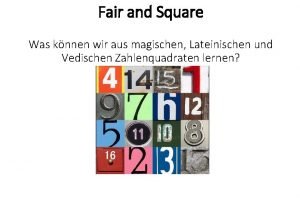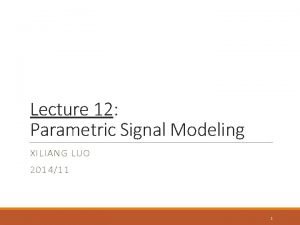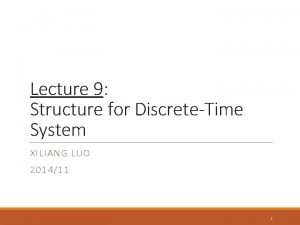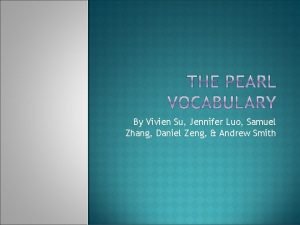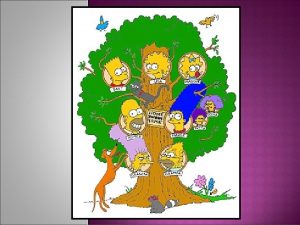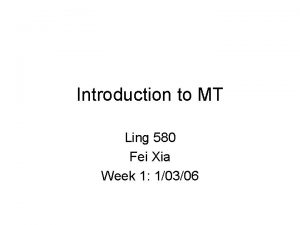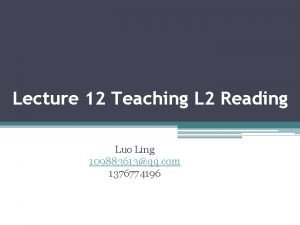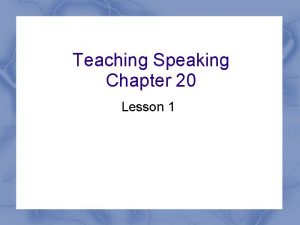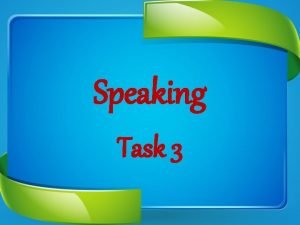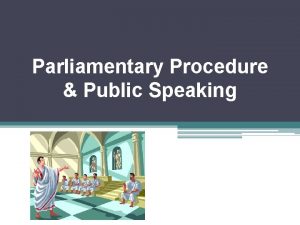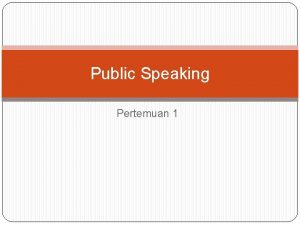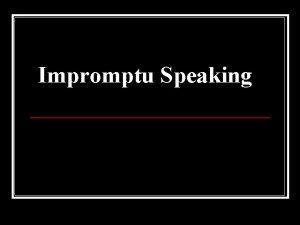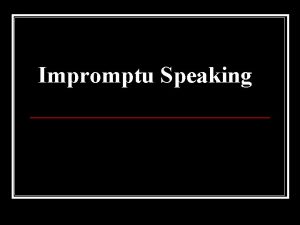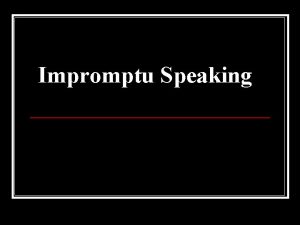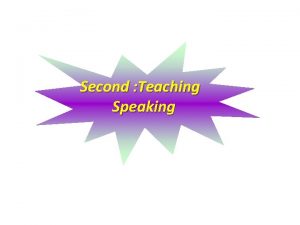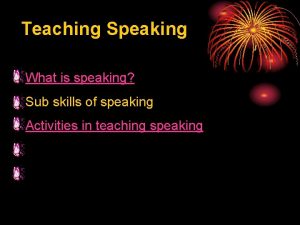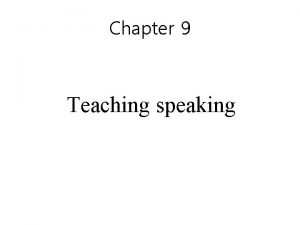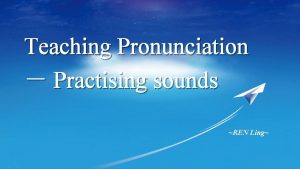Lecture 11 Teaching Speaking Luo Ling 109883613qq com
























- Slides: 24

Lecture 11 Teaching Speaking Luo Ling 109883613@qq. com 1376774196

outline SectionⅠ 1. What is speaking 2. The characteristics of spoken language 2. 1 Differences btw speaking and writing 3. Goals and objectives 4. Two complementary levels of training 5. Principles for designing speaking activities 6. Speaking activities 7. Stages in teaching speaking 8. Assessment Scale for Speaking 8. 1 Fluency 8. 2 Delivery 8. 3 Structure 8. 4 Expression

Section II teaching of pronunciation 1. Pronunciation Factors affecting pronunciation learning 2. Realistic goals of teaching pronunciation 3. Pronunciation is an umbrella term covering many aspects: 3. 1 Stress, rhythm, and intonation 3. 2 What to teach 3. Activities for teaching pronunciation

1. What is speaking? • Speaking is the skill that students will be judged upon most in real-life situations. It is such an important part of everyday interaction and most often the first impression of a person is based on hisher ability to speak fluently and comprehensibly. So, as teachers, we have the responsibility to prepare students as much as possible to be able to speaking in English both in the real world and in the testing room.

2. The characteristics of spoken language • Speaking is a skill. (A skill can be imitated and practiced. ) • Speaking is spontaneous. (People do not plan ahead of time what they are going to say. ) • Speaking is the time-constraint. (People must be able to produce unplanned utterances in real time. )

2. 1 Differences btw speaking and writing Spoken language Written language Auditory Visual Temporary, immediate reception Permanent, delayed reception Immediate feedback Delayed or no feedback Planning &editing limited by channel (medium, message) Unpredictable Unlimited planning, editing, revision Predictable

3. Goals and objectives • The ability to articulate phonological features of the language comprehensibly; • Mastery of stress, rhythm, intonation patterns; • An acceptable degree of fluency; • Transactional and interactional skills; • Skills in taking short and long speaking turn; • Skills in the management of interaction; • Skills in the negotiating meaning; • Conversational listening skills; • Skills in knowing about and negotiating purposes for conversations; • The ability to use appropriate conversational formulae and fillers.

4. Two complementary levels of training To develop in our students the ability to express themselves intelligibly, reasonably accurately and without too much hesitation, the teacher will need to give the students two complementary levels of training: • manipulated practice of fixed elements of the language, such as, phonological and grammatical patterns, together with vocabulary; • opportunities for the expression of personal opinions.

5. Principles for designing speaking activities • Maximum foreign talk (students talk time in the foreign language) • Even participation (equal opportunities for students of different levels) • High motivation (the topic; the types of tasks; a clear objective) • Right language level (avoid giving up or reverting to native language)

Use pictures to make up stories Match expressions in two columns to make a dialogue drills repetition games Prompted dialogue 6. Speakin g activities Gapped dialogue discussion Read and act Role play Information gap Make up a dialogue in a given situation Scrambled dialogue Interviews using a questionnaire

7. Stages in teaching speaking Pre-speaking While-speaking Post-speaking purpose; interest; topic; context; language input; assigning tasks description; role-play; exchanging info. ; discussion; speech; debate… making a report; evaluation; writing…

8. Assessment Scale for Speaking • • Fluency Delivery Structure Expression

8. 1 Fluency • Smooth, even speech-delivered at a comfortable rate-hesitations are rare and natural-the speaker is able to link, respond and rephrase effortlessly. • Coherence and speed is comfortable and appropriate— some hesitancy and disjointed speech is noted. • Delivery may be slow, uneven and restricted at times— however overall fluency is adequate to achieve the task. • Incomplete utterances—frequent hesitations—delivery is labored and/or incoherent—fluency only achieved on stock phrases. • Fragmented—incoherent—extremely slow.

8. 2 Delivery • Completely intelligible—pronunciation, rhythm and intonation are completely effective—accent does not intrude. • Occasional inaccuracies of pronunciation, rhythm and intonation are noted however, speech is readily comprehensible —accent may at times require more concentrated listening. • Pronunciation, rhythm and intonation are heavily influenced by L 1—Repetition is required—some misunderstanding occurs— concentrated listening is required frequently. • Very strong influence from L 1—understanding is difficult— frequent repetition required. • Unintelligible.

8. 3 Structure • Grammatical inaccuracies are minor and occasional and do not intrude. • A few major and several minor error patterns are noted— control of grammar and structure may be reduced in longer utterances. • Grammatical and structural inaccuracies are frequent— sometimes causing confusion—control over only basic grammar and structure. • Speech is full of grammatical inaccuracies leading to confusion for the listener. • Unable to function in English due to the severity of grammatical and structural problems.

8. 4 Expression • Word choice is accurate—vocabulary range is wide and effective—register, tone and style are appropriate. • Some inaccuracies in word choice and form occur, however vocabulary range is generally effective-- register, tone and style are generally appropriate. • Some misunderstanding arises due to limitations in word choice, form and range—speaker successfully covers gaps. • Frequent inaccuracies and gaps in expression—vocabulary is limited to basic expression. • Vocabulary is inadequate to complete the task—inaccuracies prohibit communication.

Section II • Teaching of pronunciation

1. Factors affecting pronunciation learning ØLearners’ native language ØAge (critical period hypothesis P 92) ØExposure ØInnate phonetic ability ØMotivation and concern for good pronunciation

2. Realistic goals of teaching pronunciation Intelligibility: The pronunciation should be smooth and natural. Consistency: The pronunciation should be understandable to the listeners. Communicative efficiency: The pronunciation should help to convey the meaning that is intended by the speaker.

pronunciation is an umbrella term covering many aspects: 3. sounds stress rhythm pronunciation intonation Phonetic symbols

3. 1 Stress, rhythm, and intonation Stress is the pronunciation of a word or syllable with more force than the surrounding words or syllables. Rhythm is a regular repeated pattern of sounds. Intonation is often described as the music of speech —the way the voice goes up and down as we speak.

3. 2 What to teach sounds………the vowels and consonants combination of sounds……. pronunciation of words word stress…. the stress in a word and shift of stress strong & weak forms…the importance of the different syllables in maintaining the rhythm of the speech, especially the model verbs and auxiliary verbs linkage of sounds……. . the liaison of sound in natural speech rhyme & rhythm pitch & intonation…the function of pitch and intonation in conveying meaning

4. Activities for teaching pronunciation say after the teacher ※ Talk with the teacher ※compare and practice minimal pairs ※Practice while listening to the tape ※understand the places and manners of articulation ※ tongue twisters ※ reading a poem ※

Thank you!
 Dậy thổi cơm mua thịt cá
Dậy thổi cơm mua thịt cá Cơm
Cơm Sevoflurane
Sevoflurane Xiliang luo
Xiliang luo Magisches quadrat 8x8 mit summe 406
Magisches quadrat 8x8 mit summe 406 Oheishuoltajan oikeudet
Oheishuoltajan oikeudet Lynn luo
Lynn luo Qiong luo
Qiong luo Chem data extractor
Chem data extractor Luo qiong
Luo qiong Xiliang luo
Xiliang luo Xiliang luo
Xiliang luo Inaudibly synonym
Inaudibly synonym 01:640:244 lecture notes - lecture 15: plat, idah, farad
01:640:244 lecture notes - lecture 15: plat, idah, farad Wang ling relationship
Wang ling relationship Ling simpson
Ling simpson Erin ling
Erin ling Ida ling
Ida ling Language
Language Ling
Ling Mtling
Mtling Dr ng li ling
Dr ng li ling Long term goals
Long term goals Ling internet
Ling internet Huo lingyu
Huo lingyu



